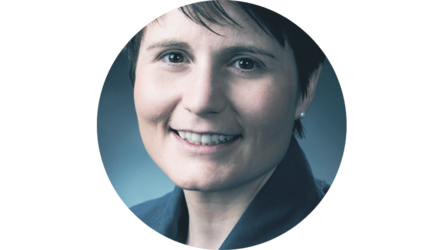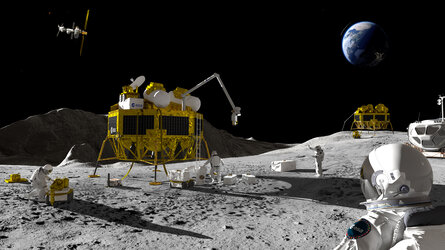I'm an ESA YGT and I work with Operations and Mission Analysis
Each year in February, the European Space Agency opens its call for applications for its Young Graduate Trainee Programme. The programme offers recently graduated Master’s students a unique opportunity to work on inspiring space missions at the heart of European space activities. Graduate Trainees join our team of scientists, engineers and business professionals from all over Europe working together in an international and friendly environment.
This week we are interviewing Marion Burnichon, who joined ESA as a Lunar Gateway Operations Engineer Graduate Trainee in October 2022. She is currently supporting our team working on the event sequencing for Artemis IV and mission analysis for future lunar exploration. Read on to learn all about her experience!

Tell us a little about yourself, e.g. your university studies, any internships you have carried out
I started my studies at McGill University with a Bachelor’s degree in physics and research in astrophysics looking at characterising light coming from neutron star mergers. Wanting to work on more applied concepts, I did my Master’s degree in aerospace engineering at ISAE-SUPAERO with a specialisation in space systems engineering and research in trajectory optimisation for lunar missions. I validated my degree with an internship at Airbus Defence and Space in mission analysis before working for a year as a flight dynamics engineer operating OneWeb’s satellite constellation.
What encouraged you to apply to become an ESA Young Graduate Trainee?
Personally, I am interested in human spaceflight, which, for now in Europe, is only dealt with by space agencies. This was my main reason to apply to ESA’s Young Graduate Trainee Programme. Additionally, I thought it was a great opportunity to get to know the agency from a different perspective than a staff member or contractor: it is a good way to see if ESA is a working environment that suits you.
What does your work at ESA entail?
I split my time between two projects on the topic of lunar exploration. The first project looks at studying the sequence of events for operations from launch to docking including ingress, outfitting, check-out and activation of ESA modules for Artemis IV. The second project deals with mission analysis of a future exploration architecture where I currently study near-rectilinear halo orbit (NRHO) phasing strategies for lunar missions.

What is working at ESA like for you?
My work is very different between the two projects. With the first one, it deals a lot more with planning and the high-level aspects of a space mission, so it requires many interactions with external parties (NASA, DLR, TAS etc.) to put all the pieces together and create the timeline of operations. For the second project, it is more independent: I study a certain phase of a mission and submit some work to the project but continue to dig deeper into the problem itself for future mission needs.
Can you tell us more about life at ESTEC?
My traineeship is ESTEC-based, which is quite an advantage. It is a huge establishment, which means you have experts on all topics within walking distance. Additionally, the site has a very wide variety of activities, particularly in sport teams, which together with its restaurant/bar ESCAPE makes for a convivial after-work setting. Young ESA is also a huge part of bringing the young professional community together, and with their social event committee, you can meet trainees across all directorates. Many activities are organised to discover ESA, Leiden, the Netherlands and even the rest of Europe.
What is your best memory so far as a Young Graduate Trainee?
Through Young ESA, I helped organise the Young Professional Event 2023 where we gathered over 200 young professionals for a day of talks, workshops and panels about the environment. After having worked for over six months with an organising team split among all the ESA sites, everyone came together at ESTEC the day before the event. My best memory is seeing us all in the meeting room the night before the event, working on finalising the speeches, questions for panels, etc. It felt like real teamwork and the excitement for the upcoming event was there.
What has been the biggest challenge for you?
The biggest challenge I’ve faced is the sheer size of the project I work on. The Gateway is a space station that will orbit the moon, something we have never done before. It requires a big team, multiple countries, and the time scale of the project is well beyond my traineeship. I am able to participate and contribute to the project, but it can be frustrating to know you will not be there from start to finish.
What advice do you have for our readers who might be interested in pursuing a career in operations/mission analysis at ESA?
When it comes to operations, you need to be in the control room to learn, so if you are looking to pursue a career in operations, I would advise to apply directly to operations-related programmes/job openings. The skills required are quite diverse and you need to show initiative and willingness to learn. For mission analysis, I would advise to work on optimisation tools and the mathematics and physics behind different environments (LEO, cislunar etc.). It can also be handy to know the sub-systems of a spacecraft and how they can be sized differently depending on the space mission.

Want to learn more?
Find detailed information on the Young Graduate Trainee Programme and answers to your most common questions on the dedicated FAQ page. Check out this page to discover other programmes available at ESA!
Life at ESA
Learn more about life at ESA or visit our ESA establishment pages to learn more about our working life.
Stay connected with us!
Join us on our Careers website and subscribe to our careers news. Follow us on social media.















 Germany
Germany
 Austria
Austria
 Belgium
Belgium
 Denmark
Denmark
 Spain
Spain
 Estonia
Estonia
 Finland
Finland
 France
France
 Greece
Greece
 Hungary
Hungary
 Ireland
Ireland
 Italy
Italy
 Luxembourg
Luxembourg
 Norway
Norway
 The Netherlands
The Netherlands
 Poland
Poland
 Portugal
Portugal
 Czechia
Czechia
 Romania
Romania
 United Kingdom
United Kingdom
 Slovenia
Slovenia
 Sweden
Sweden
 Switzerland
Switzerland































